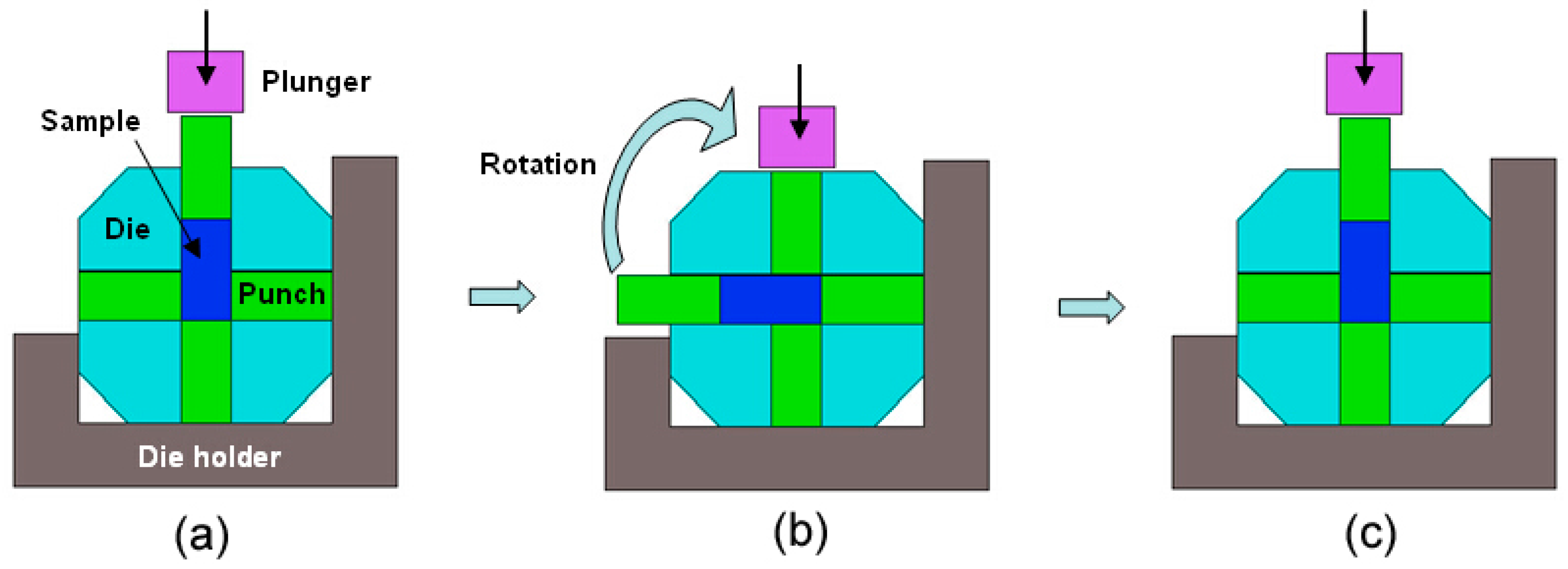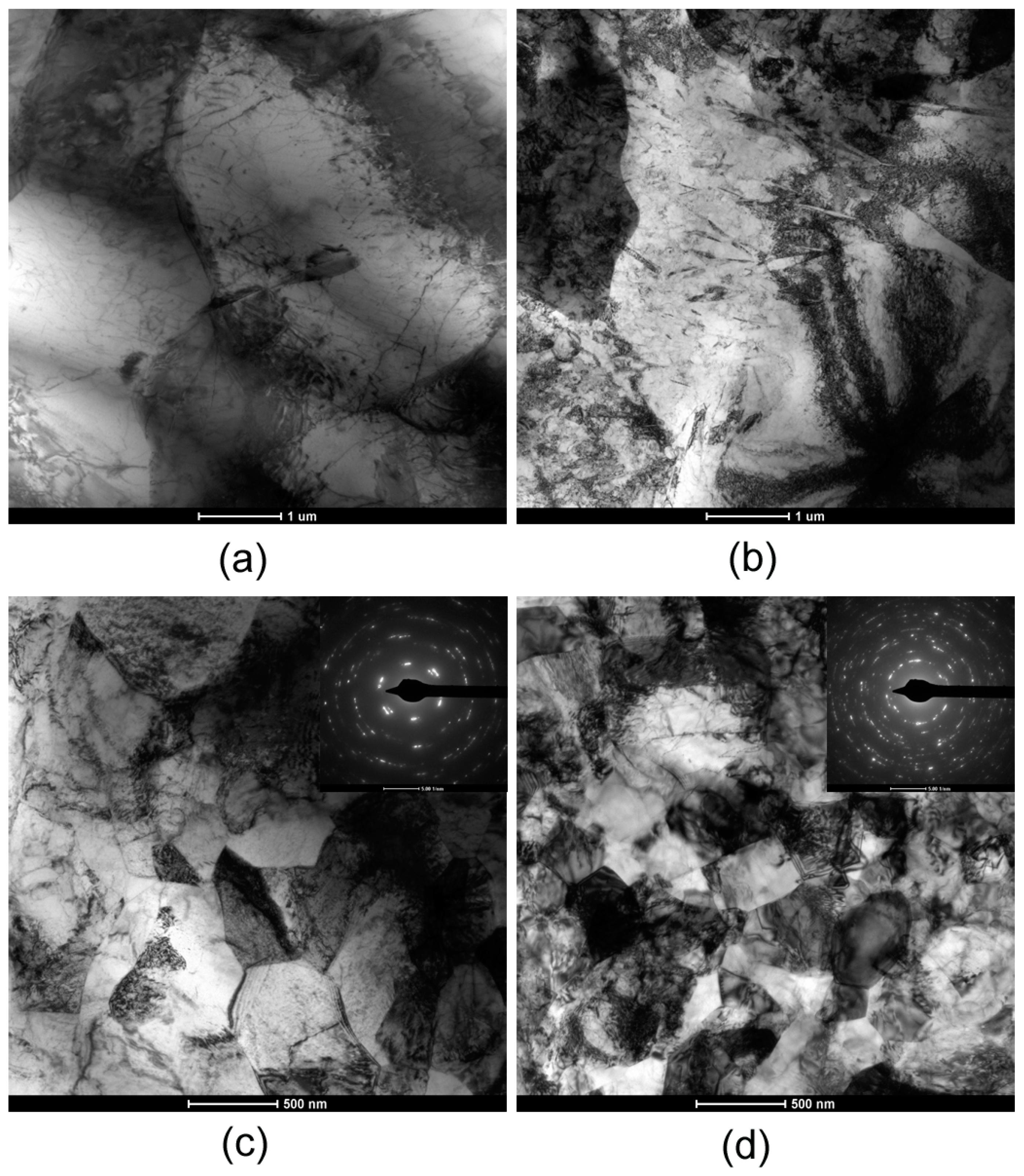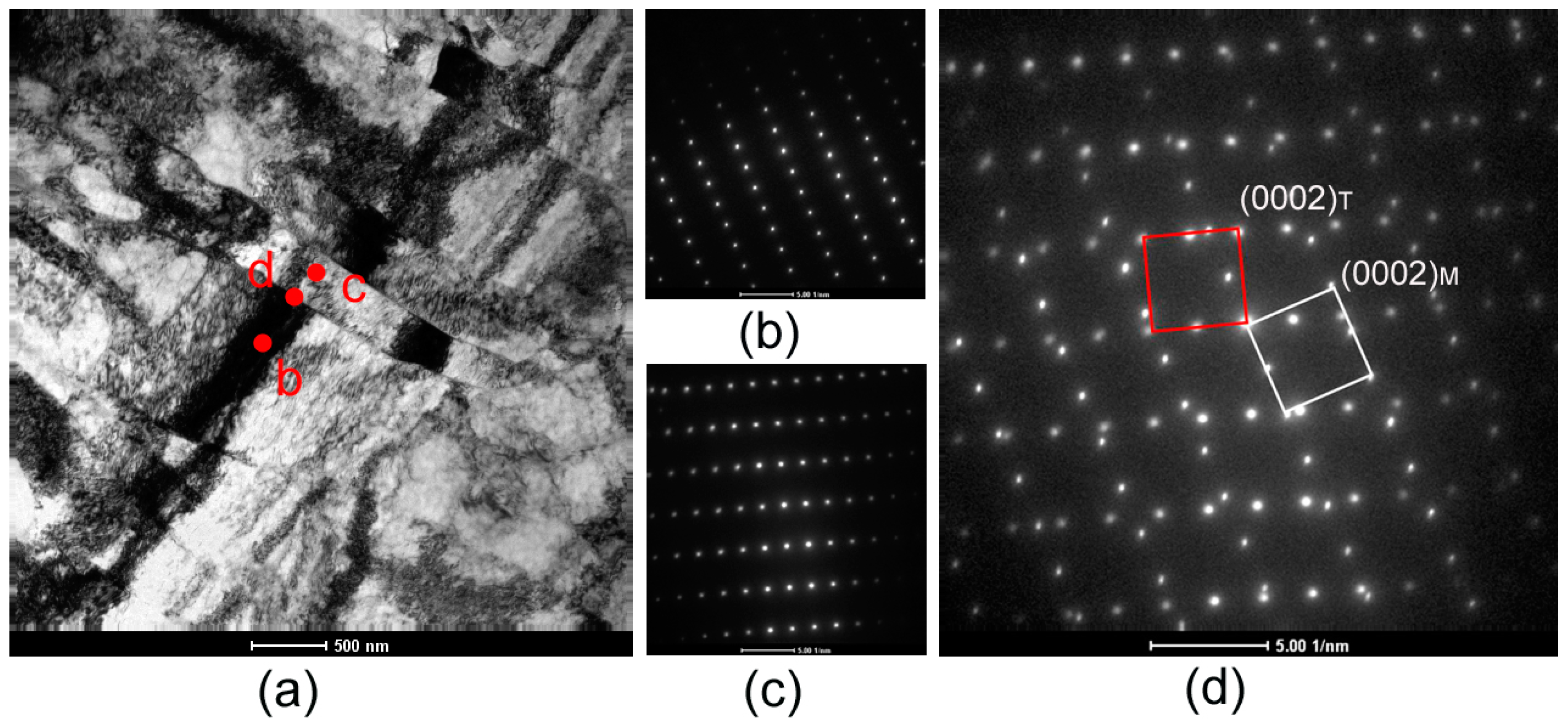Deformation Structure and Mechanical Properties of Pure Titanium Produced by Rotary-Die Equal-Channel Angular Pressing
Abstract
:1. Introduction
2. Materials and Methods
3. Results
3.1. Microstructure Evolution of Pure Titanium during RD-ECAP
3.2. Mechanical Properties after RD-ECAP Processing
4. Discussion
4.1. Microstructure Characteristics and Deformation Behavior
4.2. Mechanical Properties
5. Conclusions
- (1)
- Pure titanium of grade 2 was successfully processed by RD-ECAP up to four passes at 420 °C. There was no cracking on the sample surface.
- (2)
- During the first and second passes of RD-ECAP, plastic deformation was accommodated mainly by twins, while the predominant deformation mechanism was dislocation slip during the third and fourth passes. {} twins were detected in the first pass, and {} twins occurred in the second pass of RD-ECAP.
- (3)
- There was an increase of ~39% in ultimate tensile strength after processing by RD-ECAP for four passes. The ultimate tensile strength increased from 450 MPa of the as-received condition to 627 MPa after four passes of RD-ECAP, while the elongation decreased from ~48% to ~29%.
Acknowledgments
Author Contributions
Conflicts of Interest
References
- Valiev, R.Z.; Langdon, T.G. Principles of equal-channel angular pressing as a processing tool for grain refinement. Prog. Mater. Sci. 2006, 51, 881–981. [Google Scholar] [CrossRef]
- Valiev, R.Z.; Estrin, Y.; Horita, Z.; Langdon, T.G.; Zehetbauer, M.J.; Zhu, Y. Producing bulk ultrafine-grained materials by severe plastic deformation: Ten years later. JOM 2016, 68, 1216–1226. [Google Scholar] [CrossRef]
- Valiev, R.Z.; Islamgaliev, R.K.; Alexandrov, I.V. Bulk nanostructured materials from severe plastic deformation. Prog. Mater. Sci. 2000, 45, 103–189. [Google Scholar] [CrossRef]
- Nishida, Y.; Arima, H.; Kim, J.; Ando, T. Rotary-die equal-channel angular pressing of an al-7mass%si-0.35mass%mg alloy. Scr. Mater. 2001, 45, 261–266. [Google Scholar] [CrossRef]
- Ma, A.B.; Nishida, Y.; Suzuki, K.; Shigematsu, I.; Saito, N. Characteristics of plastic deformation by rotary-die equal-channel angular pressing. Scr. Mater. 2005, 52, 433–437. [Google Scholar] [CrossRef]
- Yoon, S.C.; Seo, M.H.; Krishnaiah, A.; Kim, H.S. Finite element analysis of rotary-die equal channel angular pressing. Mater. Sci. Eng. A 2008, 490, 289–292. [Google Scholar] [CrossRef]
- Elias, C.N.; Meyers, M.A.; Valiev, R.Z.; Monteiro, S.N. Ultrafine grained titanium for biomedical applications: An overview of performance. J. Mater. Res. Technol. 2013, 2, 340–350. [Google Scholar] [CrossRef]
- Xu, S.; Toth, L.S.; Schuman, C.; Lecomte, J.S.; Barnett, M.R. Dislocation mediated variant selection for secondary twinning in compression of pure titanium. Acta Mater. 2017, 124, 59–70. [Google Scholar] [CrossRef]
- Chun, Y.B.; Yu, S.H.; Semiatin, S.L.; Hwang, S.K. Effect of deformation twinning on microstructure and texture evolution during cold rolling of cp-titanium. Mater. Sci. Eng. A 2005, 398, 209–219. [Google Scholar] [CrossRef]
- Li, X.; Duan, Y.L.; Xu, G.F.; Peng, X.Y.; Dai, C.; Zhang, L.G.; Li, Z. Ebsd characterization of twinning in cold-rolled cp-ti. Mater. Charact. 2013, 84, 41–47. [Google Scholar] [CrossRef]
- Tirry, W.; Bouvier, S.; Benmhenni, N.; Hammami, W.; Habraken, A.M.; Coghe, F.; Schryvers, D.; Rabet, L. Twinning in pure ti subjected to monotonic simple shear deformation. Mater. Charact. 2012, 72, 24–36. [Google Scholar] [CrossRef]
- Won, J.W.; Kim, D.; Hong, S.G.; Lee, C.S. Anisotropy in twinning characteristics and texture evolution of rolling textured high purity alpha phase titanium. J. Alloys Compd. 2016, 683, 92–99. [Google Scholar] [CrossRef]
- Xu, F.; Zhang, X.; Ni, H.; Liu, Q. Deformation twinning in pure ti during dynamic plastic deformation. Mater. Sci. Eng. A 2012, 541, 190–195. [Google Scholar] [CrossRef]
- Jin, S.; Marthinsen, K.; Li, Y. Formation of {1121} twin boundaries in titanium by kinking mechanism through accumulative dislocation slip. Acta Mater. 2016, 120, 403–414. [Google Scholar] [CrossRef]
- Hong, D.H.; Hwang, S.K. Microstructural refinement of cp-ti by cryogenic channel-die compression involving mechanical twinning. Mater. Sci. Eng. A 2012, 555, 106–116. [Google Scholar] [CrossRef]
- Wang, T.; Li, B.; Li, M.; Li, Y.; Wang, Z.; Nie, Z. Effects of strain rates on deformation twinning behavior in α-titanium. Mater. Charact. 2015, 106, 218–225. [Google Scholar] [CrossRef]
- Hama, T.; Nagao, H.; Kobuki, A.; Fujimoto, H.; Takuda, H. Work-hardening and twinning behaviors in a commercially pure titanium sheet under various loading paths. Mater. Sci. Eng. A 2015, 620, 390–398. [Google Scholar] [CrossRef] [Green Version]
- Kim, I.; Kim, J.; Shin, D.H.; Lee, C.S.; Hwang, S.K. Effects of equal channel angular pressing temperature on deformation structures of pure ti. Mater. Sci. Eng. A 2003, 342, 302–310. [Google Scholar] [CrossRef]
- Li, Y.J.; Chen, Y.J.; Walmsley, J.C.; Mathinsen, R.H.; Dumoulin, S.; Roven, H.J. Faceted interfacial structure of {} twins in ti formed during equal channel angular pressing. Scr. Mater. 2010, 62, 443–446. [Google Scholar] [CrossRef]
- Chen, Y.J.; Li, Y.J.; Walmsley, J.C.; Dumoulin, S.; Gireesh, S.S.; Armada, S.; Skaret, P.C.; Roven, H.J. Quantitative analysis of grain refinement in titanium during equal channel angular pressing. Scr. Mater. 2011, 64, 904–907. [Google Scholar] [CrossRef]
- Zhao, X.; Fu, W.; Yang, X.; Langdon, T.G. Microstructure and properties of pure titanium processed by equal-channel angular pressing at room temperature. Scr. Mater. 2008, 59, 542–545. [Google Scholar] [CrossRef]
- Zhang, Y.; Figueiredo, R.B.; Alhajeri, S.N.; Wang, J.T.; Gao, N.; Langdon, T.G. Structure and mechanical properties of commercial purity titanium processed by ecap at room temperature. Mater. Sci. Eng. A 2011, 528, 7708–7714. [Google Scholar] [CrossRef]
- Chen, Y.J.; Li, Y.J.; Xu, X.J.; Hjelen, J.; Roven, H.J. Novel deformation structures of pure titanium induced by room temperature equal channel angular pressing. Mater. Lett. 2014, 117, 195–198. [Google Scholar] [CrossRef]
- Stolyarov, V.V.; Zeipper, L.; Mingler, B.; Zehetbauer, M. Influence of post-deformation on cp-ti processed by equal channel angular pressing. Mater. Sci. Eng. A 2008, 476, 98–105. [Google Scholar] [CrossRef]
- Valiev, R.Z.; Semenova, I.P.; Jakushina, E.; Latysh, V.V.; Rack, H.J.; Lowe, T.C.; Petruželka, J.; Dluhoš, L.; Hrušák, D.; Sochová, J. Nanostructured spd processed titanium for medical implants. Mater. Sci. Forum 2008, 584–586, 49–54. [Google Scholar] [CrossRef]
- Meredith, C.S.; Khan, A.S. The microstructural evolution and thermo-mechanical behavior of ufg ti processed via equal channel angular pressing. J. Mater. Process. Technol. 2015, 219, 257–270. [Google Scholar] [CrossRef]
- Kim, I.; Kim, J.; Shin, D.H.; Park, K.T. Effects of grain size and pressing speed on the deformation mode of commercially pure ti during equal channel angular pressing. Metall. Mater. Trans. A 2003, 34A, 1555–1558. [Google Scholar] [CrossRef]
- Kim, I.; Jeong, W.S.; Kim, J.; Park, K.T.; Shin, D.H. Deformation structures of pure ti produced by equal channel angular pressing. Scr. Mater. 2001, 45, 575–581. [Google Scholar] [CrossRef]
- Fan, Z.; Jiang, H.; Sun, X.; Song, J.; Zhang, X.; Xie, C. Microstructures and mechanical deformation behaviors of ultrafine-grained commercial pure (grade 3) ti processed by two-step severe plastic deformation. Mater. Sci. Eng. A 2009, 527, 45–51. [Google Scholar] [CrossRef]
- Shin, D.H.; Kim, I.; Kim, J.; Kim, Y.S.; Semiatin, S.L. Microstructure development during equal-channel angular pressing of titanium. Acta Mater. 2003, 51, 983–996. [Google Scholar] [CrossRef]
- Stolyarov, V.V.; Zhu, Y.T.; Lowe, T.C.; Islamgaliev, R.K.; Valiev, R.Z. A two step spd processing of ultrafine-grained titanium. Nanostruct. Mater. 1999, 11, 947–954. [Google Scholar] [CrossRef]






| Grain Size (μm) | Pressing Temperature (°C) | Pressing Speed (mm/s) | Twinning | Reference |
|---|---|---|---|---|
| ~30 | 350 | 2 | {} | Kim et al. [28] |
| ~30 | 250–450 | 2 | {} | Kim et al. [18] |
| ~28 | RT | 0.5 | {} | Zhao et al. [21] |
| ~40–120 | 390–400 | 8 | {} | Fan et al. [29] |
| - | 450 | 2 | {} | Li et al. [19] |
| ~22 | 450 | - | {}{} | Chen et al. [20] |
| ~200 | RT | - | {}{}{}{} | Chen et al. [23] |
| ~30 | 275 | 1 | {} | Meredith et al. [26] |
| ~10 | RT | 0.05 | {} | Zhang et al. [22] |
| ~10 | 420 | 0.1 | {} | Present Study |
© 2017 by the authors. Licensee MDPI, Basel, Switzerland. This article is an open access article distributed under the terms and conditions of the Creative Commons Attribution (CC BY) license (http://creativecommons.org/licenses/by/4.0/).
Share and Cite
Gu, Y.; Ma, A.; Jiang, J.; Yuan, Y.; Li, H. Deformation Structure and Mechanical Properties of Pure Titanium Produced by Rotary-Die Equal-Channel Angular Pressing. Metals 2017, 7, 297. https://doi.org/10.3390/met7080297
Gu Y, Ma A, Jiang J, Yuan Y, Li H. Deformation Structure and Mechanical Properties of Pure Titanium Produced by Rotary-Die Equal-Channel Angular Pressing. Metals. 2017; 7(8):297. https://doi.org/10.3390/met7080297
Chicago/Turabian StyleGu, Yanxia, Aibin Ma, Jinghua Jiang, Yuchun Yuan, and Huiyun Li. 2017. "Deformation Structure and Mechanical Properties of Pure Titanium Produced by Rotary-Die Equal-Channel Angular Pressing" Metals 7, no. 8: 297. https://doi.org/10.3390/met7080297




